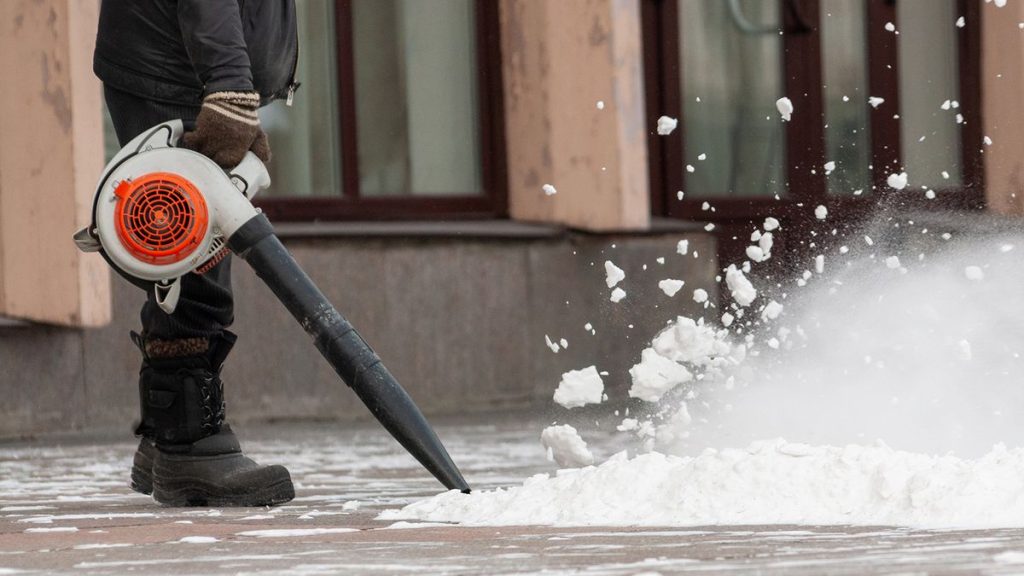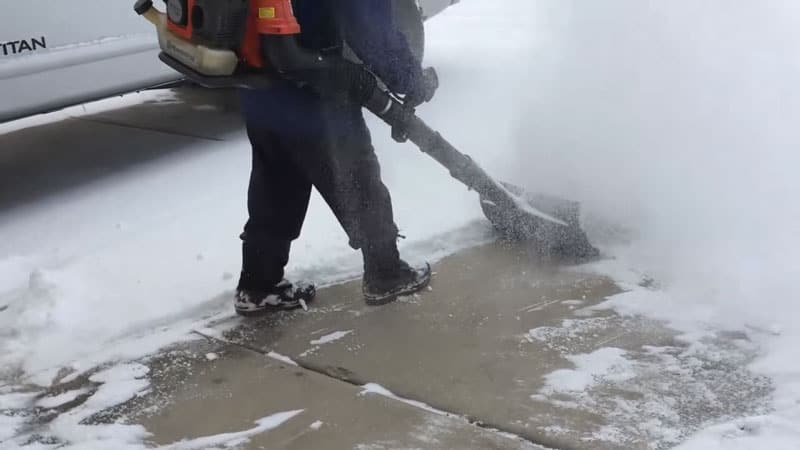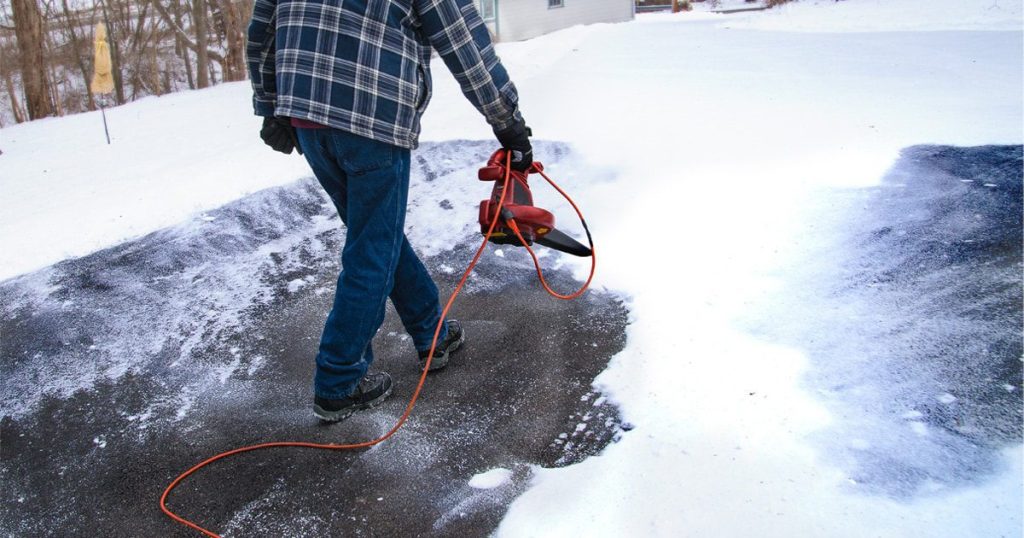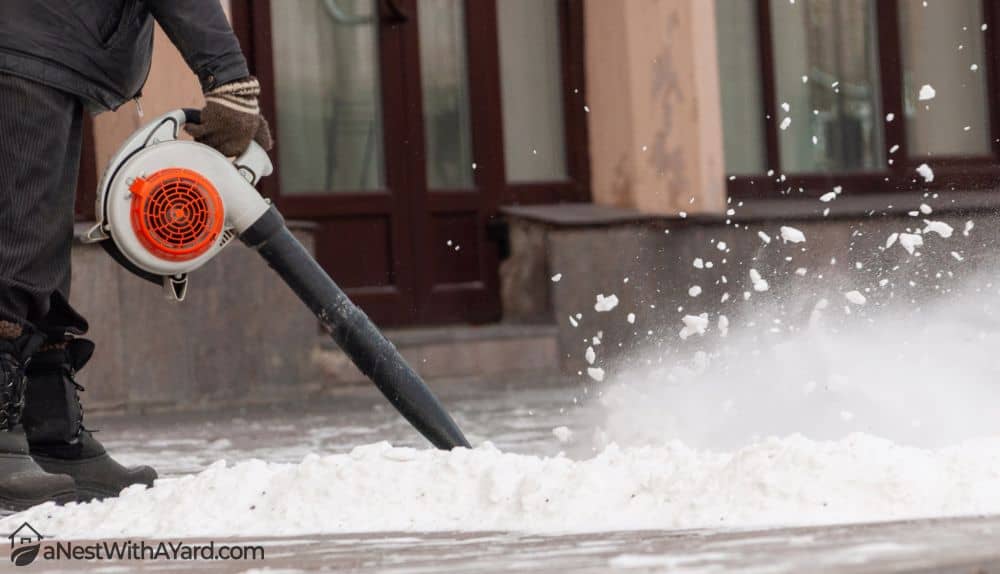If you’re tired of shoveling snow by hand every winter and you own a leaf blower, you might wonder if it can also tackle light snow.
It’s a common question among homeowners looking for a quicker and more efficient way to clear their driveways and sidewalks.
In this article, we will explore whether or not you can use a leaf blower to clear light snow and provide some helpful tips for using this handy tool during the winter months.
So, grab your cozy cup of hot cocoa, and find out if your leaf blower can save you some time this winter!
Choosing the Right Leaf Blower
When choosing a suitable leaf blower for light snow clearing, there are a few things to consider. First and foremost, you’ll want to think about the type of leaf blower that will best suit your needs.
There are three main types: handheld, backpack, and walk-behind blowers. Handheld blowers are the most common and versatile option, while backpack blowers offer more power and are ideal for larger areas. On the other hand, walk-behind blowers are excellent for clearing large amounts of snow over vast areas.
Another essential factor to consider is the leaf blower’s CFM (cubic feet per minute) and MPH (miles per hour) ratings.
These ratings indicate the air volume and speed the blower can generate, which are crucial for effectively blowing away the snow. The higher the CFM and MPH ratings, the more efficient the blower will be at clearing light snow.
Lastly, checking for cold weather features when choosing a leaf blower for light snow clearing is essential.
These features include electric start options, choke controls, and heated handles, making using the blower in cold weather much more comfortable and convenient.
Understanding Light Snowfall
Before diving into the benefits and limitations of using a leaf blower for light snow, it’s essential to understand the characteristics of light snowfall. Light snowfall is typically defined as snow that falls at a rate of 1 inch (2.5 cm) per hour or less. It is often powdery and easily blown away by even a gentle breeze.
To determine whether the snowfall is considered “light,” it’s essential to consider factors such as snow type, depth, and density.
Understanding Snow Types
Snow can come in various forms, such as dry, wet, or slushy. For effective snow clearing with a leaf blower, it’s best to deal with dry snow, as it is lighter and easier to move. Wet or slushy snow can be heavier and more challenging to blow away, so using a leaf blower for heavy or wet snow is not recommended.
Determining Snow Depth
The depth of the snow is also a crucial factor in deciding whether a leaf blower is suitable for clearing it. Light snowfall typically results in a snow depth of less than 6 inches (15 cm); anything beyond that may require different equipment or techniques.
Considering Snow Density
Snow density refers to how tightly packed the snowflakes are. Light snowfall often consists of loosely packed snowflakes, making it ideal for clearing with a leaf blower. However, if the snow density increases, it may become more challenging for the blower to move the snow effectively.
Benefits of Using a Leaf Blower for Light Snow
Using a leaf blower for light snow clearing offers several benefits, making it a popular choice among homeowners. Here are some of the advantages:
Time Efficiency
One significant benefit of using a leaf blower for light snow is the time efficiency it provides. Instead of manually shoveling snow, which can be time-consuming and physically demanding, a leaf blower lets you clear the snow quickly and with minimal effort.
Easy Maneuverability
Leaf blowers are designed to be lightweight and easy to maneuver, making them a convenient choice for light snow clearing. Whether you’re blowing snow off your driveway, patio, or walkway, a leaf blower enables you to navigate obstacles effortlessly.
No Heavy Lifting Required
Unlike shoveling snow, using a leaf blower requires no heavy lifting. This is particularly beneficial for individuals with physical limitations or those who want to avoid the strain of lifting heavy snow. A leaf blower can clear the snow without putting unnecessary stress on your back or joints.
Limitations of Using a Leaf Blower for Light Snow
While there are numerous benefits to using a leaf blower for light snow clearing, it’s essential to be aware of its limitations. Here are some limitations to consider:
Not Effective for Heavy or Wet Snow
Leaf blowers are not designed to handle heavy or wet snow. If the snowfall is too dense or the snow has turned into slush, using a leaf blower may not be effective in clearing it. In such cases, alternative snow-clearing methods may be more suitable.
Limited Clearing Capacity
Although leaf blowers can swiftly clear light snow, they have a limited clearing capacity. If you’re dealing with a large area covered in deep snow, it may take multiple passes with the blower to completely clear the area. This can be time-consuming and require extra effort.
Potential Damage to Landscaping
It’s important to note that using a leaf blower for snow clearing can potentially cause damage to delicate landscaping features. The powerful air streams that leaf blowers generate could displace or damage plants, flowers, or other landscaping elements if not used carefully. It’s crucial to be mindful of the blower’s distance from these features and adjust the settings accordingly.
Tips for Using a Leaf Blower to Clear Light Snow Safely and Effectively
To ensure safe and effective snow clearing with a leaf blower, consider the following tips:
Clearing the Area of Debris
Before using your leaf blower for snow clearing, remove any debris, such as sticks or rocks, from the area. These objects can get caught in the blower and cause damage or injury.
Adjusting the Blower Settings
Depending on the depth and density of the snow, you may need to adjust the blower settings accordingly. Start with the lowest setting and gradually increase the power if necessary. Avoid using the highest setting unless required, as it may blow away more than just the snow.
Using the Right Technique
Use a sweeping motion with the blower nozzle angled slightly downwards to get the most out of your leaf blower. This technique allows the air stream to lift and move the snow without causing unnecessary disturbance to the underlying surface. Don’t blow the snow toward roads, walkways, or neighboring properties.
Preparing Your Leaf Blower for Snow Clearing
Before winter arrives and the snow starts falling, properly preparing your leaf blower for snow clearing is crucial. Follow these steps to ensure your blower is ready for the task:
Ensure Proper Maintenance
Regular maintenance, such as cleaning the air filter, inspecting the spark plug, and lubricating moving parts, is essential for the optimal performance of your leaf blower. Consult the manufacturer’s instructions or seek professional assistance to ensure you follow the correct maintenance procedures.
Use Fuel Stabilizer in Winter
If you’re using a gas-powered leaf blower, adding a fuel stabilizer to the gasoline during winter is essential. This helps prevent the fuel from deteriorating and causing starting issues. Follow the instructions on the fuel stabilizer product for proper usage.
Protecting the Blower from Moisture
Snow and moisture can damage the electrical components of your leaf blower, so it’s crucial to take precautions. Store the blower in a dry and sheltered area when not in use, and avoid using it in wet conditions. Additionally, consider investing in a weather-resistant cover to protect it from snow and moisture when stored outdoors.
Alternatives to Leaf Blowers for Light Snow Clearing
While leaf blowers can be effective for clearing light snow, there are alternative tools available that may better suit your needs. Here are a few options to consider:
Using a Snow Shovel
A snow shovel is a traditional and reliable tool for clearing light snow. It requires manual labor, but for small areas or areas with delicate landscaping, a shovel may be a better option to avoid potential damage.
Trying Electric Snow Blowers
Electric snow blowers are lightweight and easy to use, making them a viable alternative to leaf blowers for light snow clearing. They are typically smaller and less powerful than gas-powered blowers, but they can still easily handle light snowfall.
Considering Snow Throwers
Snow throwers, also known as snow thrower attachments or snow blades, can be added to lawn tractors or riding mowers. These attachments are specifically designed for snow clearing and can be effective for light snow. However, they may not be suitable for smaller areas or areas with obstacles.
Considerations for Using Gas-Powered Leaf Blowers in Cold Weather
Gas-powered leaf blowers require additional considerations when used in cold weather. Here are some essential factors to keep in mind:
Using Fuel with the Right Octane Rating
Using gasoline with the correct octane rating is crucial for gas-powered leaf blowers, especially in cold weather. Consult the user manual or manufacturer’s recommendations to use the appropriate octane rating for optimal performance and starting reliability.
Taking Precautions for Carburetor Freezing
When temperatures drop below freezing, there is a risk of the carburetor freezing in gas-powered blowers. To minimize the chances of this occurring, consider using a fuel with a lower ethanol content, which is less prone to freezing. Additionally, allow the blower to warm up indoors before starting in freezing weather.
Storing Gas Properly in Winter
Proper fuel storage is essential during the winter months. Use approved fuel containers and store them in a cool, dry place away from direct sunlight and potential ignition sources. Ensure the containers are tightly sealed to prevent moisture from entering and causing fuel quality issues.
Understanding Local Regulations and Restrictions
Before using a leaf blower for snow clearing, it’s essential to familiarize yourself with local regulations and restrictions that may apply. Here are a few factors to consider:
Checking Noise Regulations
Some communities have noise regulations that restrict the use of leaf blowers during certain hours. Ensure you know the specific noise regulations in your area to avoid any potential violations.
Being Aware of Environmental Policies
Certain areas may have environmental policies that prohibit or limit the use of gas-powered leaf blowers. These policies aim to reduce air and noise pollution. Understand and comply with these policies to contribute to a healthier environment.
Considering Safety Guidelines
To ensure the safety of yourself and others while using a leaf blower, it’s crucial to follow general safety guidelines such as wearing eye protection, ear protection, and appropriate clothing. Additionally, be cautious of hidden obstacles or uneven surfaces that may pose a tripping or slipping hazard.
Conclusion
Using a leaf blower for light snow clearing can be time-efficient and convenient, provided you choose the suitable blower for the job and understand its limitations. Before using a leaf blower, consider the type of blower, its CFM and MPH ratings, and any cold weather features it may have. Familiarize yourself with the characteristics of light snowfall, such as snow types, depth, and density, to determine if a leaf blower is suitable.
While leaf blowers offer benefits such as time efficiency, easy maneuverability, and no heavy lifting required, they must be aware of their limitations. They may not be effective for heavy or wet snow, have limited clearing capacity, and can potentially cause damage to landscaping if not used with care.
To use a leaf blower for snow clearing safely and effectively, remember to clear the area of debris, adjust the blower settings, and use the proper technique. Preparing your leaf blower for winter by ensuring proper maintenance, using a fuel stabilizer, and protecting it from moisture is essential for optimal performance and longevity.
Lastly, consider alternatives to leaf blowers, such as snow shovels, electric snow blowers, or snow throwers, depending on the size of the area and your specific needs. Be mindful of local regulations and restrictions regarding noise, environmental policies, and safety guidelines to ensure a responsible and considerate snow-clearing experience.








































